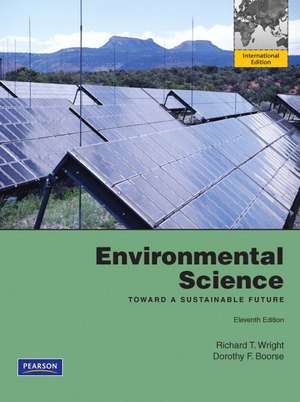Environmental Science: Toward a Sustainable Future: International Edition
Autor Richard T. Wright, Dorothy Boorseen Limba Engleză Paperback – 3 ian 2010
Preț: 394.73 lei
Preț vechi: 453.71 lei
-13% Nou
Puncte Express: 592
Preț estimativ în valută:
75.54€ • 78.57$ • 62.36£
75.54€ • 78.57$ • 62.36£
Cartea se retipărește
Doresc să fiu notificat când acest titlu va fi disponibil:
Se trimite...
Preluare comenzi: 021 569.72.76
Specificații
ISBN-13: 9780321701404
ISBN-10: 0321701402
Pagini: 696
Dimensiuni: 216 x 276 x 21 mm
Greutate: 1.34 kg
Ediția:11Nouă
Editura: Pearson Education
Colecția Pearson Education
Locul publicării:Upper Saddle River, United States
ISBN-10: 0321701402
Pagini: 696
Dimensiuni: 216 x 276 x 21 mm
Greutate: 1.34 kg
Ediția:11Nouă
Editura: Pearson Education
Colecția Pearson Education
Locul publicării:Upper Saddle River, United States
Cuprins
I. FRAMEWORK FOR A SUSTATAINABLE FUTURE
1. Science and the Environment
2. Economics, Politics, and Public Policy
II. ECOLOGY: THE SCIENCE OF ORGANISMS AND THEIR ENVIRONMENT
3. Basic Needs of Living Things
4. Populations and Communities
5. Ecosystems: Energy, Patterns, and Disturbance
6. Wild Species and Biodiversity
7. The Use and Restoration of Ecosystems
III. THE HUMAN POPULATION AND ESSENTIAL RESOURCES
8. The Human Population
9. Population and Development
10. Water: Hydrologic Cycle and Human Use
11. Soil: Foundation for Land Ecosystems
12. The Production and Distribution of Food
13. Pests and Pest Control
IV. HARNESSING ENERGY FOR HUMAN SOCIETY
14. Energy from Fossil Fuels
15. Nuclear Power
16. Renewable Energy
V. POLLUTION AND PREVENTION
17. Environmental Hazards and Human Health
18. Global Climate Change
19. Atmospheric Pollution
20. Water Pollution and Its Prevention
21. Municipal Solid Waste: Disposal and Recovery
22. Hazardous Chemicals: Pollution and Prevention
VI. STEWARDSHIP FOR A SUSTAINABLE FUTURE
23. Sustainable Communities and Lifestyles
Appendix A Environmental
Organizations
Appendix B Units of Measure
Credits
Glossary
Index
1. Science and the Environment
2. Economics, Politics, and Public Policy
II. ECOLOGY: THE SCIENCE OF ORGANISMS AND THEIR ENVIRONMENT
3. Basic Needs of Living Things
4. Populations and Communities
5. Ecosystems: Energy, Patterns, and Disturbance
6. Wild Species and Biodiversity
7. The Use and Restoration of Ecosystems
III. THE HUMAN POPULATION AND ESSENTIAL RESOURCES
8. The Human Population
9. Population and Development
10. Water: Hydrologic Cycle and Human Use
11. Soil: Foundation for Land Ecosystems
12. The Production and Distribution of Food
13. Pests and Pest Control
IV. HARNESSING ENERGY FOR HUMAN SOCIETY
14. Energy from Fossil Fuels
15. Nuclear Power
16. Renewable Energy
V. POLLUTION AND PREVENTION
17. Environmental Hazards and Human Health
18. Global Climate Change
19. Atmospheric Pollution
20. Water Pollution and Its Prevention
21. Municipal Solid Waste: Disposal and Recovery
22. Hazardous Chemicals: Pollution and Prevention
VI. STEWARDSHIP FOR A SUSTAINABLE FUTURE
23. Sustainable Communities and Lifestyles
Appendix A Environmental
Organizations
Appendix B Units of Measure
Credits
Glossary
Index
Caracteristici
- An impartial presentation is known for scientific accuracy and thorough topic coverage.
- Three unifying themes of science, sustainability, and stewardship help students conceptualize the task of forging a sustainable future.
- Essays explore the three themes at appropriate points within chapters and provide a memorable perspective on the topic. Themes are recapped and discussed at the end of each chapter to help students connect the chapter topics to the themes. A final capstone chapter revisits these themes.
- Timely coverage of topical concerns including the Aral Sea as a major environmental disaster; emerging diseases like swine flu; the 2008 World Population Data Sheet; the 2008 Iowa floods; the “green revolution;” the Endangered Species Act controversy; restoration of the Everglades, and the 2007 Global Forest Resources Assessment.
- Unique chapter on Ecosystem Capital (Chapter 7: The Use and Restoration of Ecosystems) explores how ecosystems provide valuable goods and services to society.
Caracteristici noi
- A focus on science, sustainability, and stewardship is interwoven throughout the book so that students can walk away from the course with a memorable framework for making informed decisions about environmental issues.
- Expanded Making a Difference sections appear at the end of each chapter and give students practical suggestions for promoting sustainable practices and protecting the earth for future generations.
- Fresh new graphics and photos provide a more current, vivid and appealing view of environmental science concepts.
- Earlier discussion of Economics and Policy (moved from Chapter 22 in the Tenth Edition to Chapter 2 in the Eleventh Edition) gives students a basic foundation in the social sciences before studying specific issues.
- New chapter organization provides cohesive units on Ecology (Part 2, Chapters 3-7) and Human Population and Essential Resources (Part 3, Chapters 8-13).
- The text is printed on FSC certified paper to set the gold standard in use of environmentally responsible publishing, following guidelines from the Forest Stewardship Council (FSC) for reducing energy usage, reducing impact on forests, and limiting the release of toxic chemicals into the environment.
